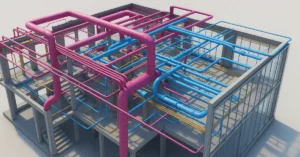Explore How BIM in Japan is Dramatically Enhancing Construction Efficiency
Building Information Modeling (BIM) is revolutionizing the construction industry worldwide, and Japan is no exception. As one of the most technologically advanced nations, Japan has been quick to adopt and integrate BIM into its construction practices. BIM’s comprehensive approach to design, construction, and facility management is enhancing efficiency, reducing costs, and improving the quality of construction projects across the country. This article explores how BIM is enhancing construction efficiency in Japan, focusing on its implementation, benefits, challenges, and future prospects.
The State of the Construction Industry in Japan
Japan’s construction industry is one of the largest in the world, characterized by advanced technology, high-quality standards, and a strong emphasis on sustainability. However, the industry also faces significant challenges, including an aging workforce, labor shortages, and the need for improved productivity. Traditional construction methods, while reliable, are often time-consuming and prone to errors, leading to delays and increased costs. This is where BIM comes into play, offering a modern solution to these persistent issues.
What is BIM?
BIM, or Building Information Modeling, is a digital representation of the physical and functional characteristics of a building. It provides a shared knowledge resource for information about a facility, forming a reliable basis for decisions during its lifecycle, from inception to demolition. BIM integrates various aspects of the construction process, including design, construction, and operations, into a single, coherent system. This integration enables better collaboration, improved accuracy, and enhanced efficiency in construction projects.
BIM Implementation in Japan
Japan has been proactive in adopting BIM, driven by both government initiatives and industry demand. The Japanese government has been promoting the use of BIM through various policies and guidelines, recognizing its potential to enhance construction efficiency and sustainability. Major construction firms in Japan, such as Obayashi Corporation, Taisei Corporation, and Shimizu Corporation, have also been pioneers in implementing BIM in their projects.
Government Initiatives
The Ministry of Land, Infrastructure, Transport and Tourism (MLIT) has been instrumental in promoting BIM adoption in Japan. In 2010, MLIT released the “BIM Guidelines for Architectural Design,” encouraging the use of BIM in public construction projects. Since then, the government has continued to support BIM through various initiatives, including the development of national BIM standards and the promotion of BIM education and training programs.
Industry Adoption
Leading construction companies in Japan have been quick to recognize the benefits of BIM and have integrated it into their workflows. These companies have invested in BIM software and technology, trained their staff in BIM methodologies, and developed proprietary BIM systems tailored to their specific needs. The adoption of BIM by these industry leaders has set a benchmark for other firms, driving widespread adoption across the construction sector.
Benefits of BIM in Enhancing Construction Efficiency
The adoption of BIM in Japan is yielding significant benefits, enhancing construction efficiency in multiple ways. Here are some of the key advantages:
Improved Collaboration
BIM facilitates better collaboration among all stakeholders involved in a construction project. By providing a central repository of information that is accessible to architects, engineers, contractors, and clients, BIM ensures that everyone is on the same page. This reduces misunderstandings, minimizes errors, and ensures that all parties are working towards the same goals. The collaborative nature of BIM is particularly beneficial in Japan, where teamwork and coordination are highly valued.
Enhanced Design Accuracy
BIM allows for the creation of highly detailed and accurate 3D models of buildings. These models include precise information about dimensions, materials, and systems, enabling more accurate design and planning. This level of detail helps to identify and resolve potential issues early in the design process, reducing the likelihood of costly changes and rework during construction. The accuracy of BIM models also facilitates better coordination between different disciplines, such as architecture, structural engineering, and MEP (mechanical, electrical, and plumbing) engineering.
Increased Productivity
BIM streamlines the construction process, leading to increased productivity. By providing detailed construction plans and schedules, BIM helps to optimize the use of resources, minimize downtime, and reduce waste. The use of BIM also enables more efficient project management, as it provides real-time data and insights that can be used to monitor progress, identify bottlenecks, and make informed decisions. In a country like Japan, where efficiency and productivity are paramount, these benefits are particularly valuable.
Cost Savings
One of the most significant benefits of BIM is its potential to reduce costs. By improving design accuracy and coordination, BIM helps to minimize errors and rework, which are major sources of cost overruns in construction projects. BIM also enables more accurate cost estimation and budgeting, as it provides detailed information about quantities and materials. Additionally, the use of BIM can lead to savings in labor costs, as it streamlines workflows and reduces the need for manual processes.
Enhanced Facility Management
BIM is not only beneficial during the construction phase but also throughout the lifecycle of a building. The detailed information contained in BIM models can be used for facility management, enabling more efficient operation and maintenance. This is particularly important in Japan, where the emphasis on sustainability and long-term value is driving the need for better building management practices. BIM provides a valuable tool for managing building assets, ensuring that they are maintained in optimal condition and delivering maximum value over their lifespan.
Challenges and Solutions in BIM Adoption
Despite the numerous benefits of BIM, its adoption in Japan is not without challenges. Some of the key obstacles include:
High Initial Costs
The implementation of BIM requires significant investment in software, hardware, and training. For small and medium-sized enterprises (SMEs), these costs can be prohibitive. To address this challenge, the Japanese government and industry associations are providing support and incentives for SMEs to adopt BIM. Additionally, cloud-based BIM solutions are emerging as a cost-effective alternative, reducing the need for expensive infrastructure.
Skill Shortage
The successful implementation of BIM requires skilled professionals who are proficient in BIM software and methodologies. However, there is a shortage of such professionals in Japan. To address this issue, educational institutions and industry organizations are offering BIM training programs and courses. Companies are also investing in the development of in-house BIM expertise through training and professional development initiatives.
Resistance to Change
Like in many other countries, there is resistance to change within the Japanese construction industry. Some stakeholders are reluctant to adopt new technologies and workflows, preferring to stick with traditional methods. To overcome this resistance, it is important to demonstrate the tangible benefits of BIM and provide support for its implementation. Pilot projects and case studies showcasing the successful use of BIM can help to build confidence and encourage wider adoption.
Interoperability Issues
Interoperability between different BIM software and systems is a common challenge. In Japan, efforts are being made to develop national BIM standards and guidelines to ensure compatibility and facilitate data exchange. Industry collaboration and the use of open standards, such as the Industry Foundation Classes (IFC) format, are also helping to address interoperability issues.
Case Studies: BIM in Action in Japan
Several high-profile construction projects in Japan have successfully utilized BIM, demonstrating its potential to enhance efficiency and deliver superior outcomes. Here are a few notable examples:
Tokyo 2020 Olympic Stadium
The Tokyo 2020 Olympic Stadium, designed by renowned architect Kengo Kuma, is a prime example of BIM in action. The project utilized BIM for design coordination, clash detection, and construction management. BIM helped to streamline the construction process, ensuring that the stadium was completed on time and within budget. The use of BIM also facilitated collaboration among the various stakeholders, including architects, engineers, and contractors, resulting in a world-class facility that met the highest standards of quality and sustainability.
Shibuya Station Redevelopment
The Shibuya Station Redevelopment project, one of the largest and most complex construction projects in Tokyo, also leveraged BIM to enhance efficiency. The project involved the renovation and expansion of one of Tokyo’s busiest transport hubs, requiring meticulous planning and coordination. BIM was used to create detailed 3D models of the existing structures and the new design, enabling precise planning and coordination. The use of BIM helped to minimize disruptions to the station’s operations, optimize construction schedules, and ensure the safety of workers and commuters.
Taisei Corporation’s Smart BIM Project
Taisei Corporation, one of Japan’s leading construction firms, has been a pioneer in the use of BIM. The company’s Smart BIM Project involves the integration of BIM with other advanced technologies, such as IoT and AI, to create intelligent construction solutions. Through this project, Taisei has demonstrated how BIM can be used to optimize construction processes, enhance project management, and improve the overall quality of construction. The Smart BIM Project has set a benchmark for innovation in the construction industry, showcasing the potential of BIM to transform the way buildings are designed, constructed, and managed.
The Future of BIM in Japan
The future of BIM in Japan looks promising, with continued growth and innovation on the horizon. The Japanese government and industry leaders are committed to promoting BIM adoption, recognizing its potential to enhance efficiency, sustainability, and competitiveness. As technology continues to advance, BIM is expected to become even more powerful, integrating with other emerging technologies such as artificial intelligence, machine learning, and the Internet of Things (IoT).
Integration with Emerging Technologies
The integration of BIM with emerging technologies is set to further enhance its capabilities. For example, the use of AI and machine learning can enable predictive analytics, helping to identify potential issues and optimize construction processes. The IoT can be used to collect real-time data from construction sites, providing valuable insights for project management and decision-making. The combination of BIM with these technologies can lead to smarter, more efficient construction practices, driving further improvements in productivity and quality.
Greater Emphasis on Sustainability
Sustainability is a key focus in Japan’s construction industry, and BIM is playing a crucial role in promoting sustainable building practices. By providing detailed information about materials, energy consumption, and environmental impact, BIM enables more sustainable design and construction. The use of BIM can help to optimize resource use, reduce waste, and minimize the environmental footprint of buildings. As sustainability becomes increasingly important, the role of BIM in promoting green construction practices is expected to grow.
Wider Adoption Across the Industry
While large construction firms in Japan have been at the forefront of BIM adoption, there is still significant potential for wider adoption across the industry. The Japanese government and industry associations are working to promote BIM adoption among SMEs, recognizing the benefits it can bring to smaller firms. As awareness of the benefits of BIM continues to grow, it is expected that more companies will adopt BIM, driving industry-wide improvements in efficiency and quality.
Conclusion
BIM is transforming the construction industry in Japan, enhancing efficiency, reducing costs, and improving the quality of construction projects. The proactive adoption of BIM by the Japanese government and industry leaders has set a benchmark for innovation, demonstrating the significant benefits of this technology. While there are challenges to overcome, the future of BIM in Japan looks bright, with continued growth and integration with emerging technologies on the horizon. As Japan continues to lead the way in construction innovation, BIM will play a crucial role in shaping the future of the industry, driving improvements in efficiency, sustainability, and overall project outcomes.
If you’re interested in learning more about architecture firms in Europe, check out this comprehensive list of the top 50 firms compiled by Archgyan. From innovative startups to long-established industry leaders, this list has it all. Take a look and discover some of the most inspiring and influential architecture firms in Europe today.
If you’re interested in architecture and want to learn more about this amazing field, subscribe to our podcast on youtube
For more SketchUp tutorials, head to https://www.sketchupguru.com










